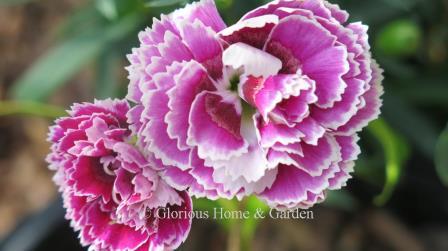- Home
- The Summer Garden
- Daylilies
Daylilies: Beauty for a Day
Hemerocallis, the generic classification of daylilies, means ‘beauty for a day.’ Each flower only lasts a day, but there are many buds to open on multiple stalks, or scapes, for a long succession of bloom. And though daylilies are called “lilies,” they are not true lilies, but grow from tough, fibrous roots rather than bulbs like true lilies.
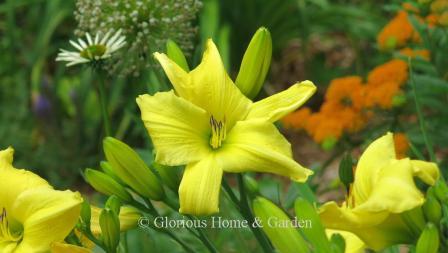 Hemerocallis 'Winning Ways' in the summer border.
Hemerocallis 'Winning Ways' in the summer border.Are daylilies the ideal perennial? They are certainly very versatile. They can be used in mass groupings, or as individual specimens in the mixed perennial border. They come in many sizes from tiny miniatures to large blooms of over 5” wide. They have varied forms from the simple shapes of the species, to extremely ruffled, to elongated spidery shapes, and they are easy to grow, reliable and beautiful. The grassy foliage is neat and attractive all season, and they have few insect or disease problems.
The color range is astounding from near white, cream, melon, orange, pink, rose, red, purple, wine to almost black. The only colors eluding hybridizers are true white and blue—and they will probably achieve those. And the patterns and color combinations of recent introductions are incredible. It’s hard to imagine that all this variation has come from crossing a few species, and then re-crossing selected cultivars. No wonder daylily hybridization is so popular! Everyone wants to find that next breakthrough.
Some daylilies are quite fragrant, adding to their charm. All parts of the plant are edible, too—they have been used as a food source in Asia for centuries.
The ranking of diploid or tetraploid refers to the genetic makeup of a particular cultivar.
Diploid means that there are two sets of chromosomes in each cell. Diploids make up the majority of daylilies and are said to be easier to cross.
Tetraploid means that the cultivar has four sets of chromosomes in each cell causing sturdier growth, larger flowers, more budscapes and greater vigor.
There are thousands of cultivars available in almost any size, shape and color to work with any garden scheme or location. To choose your favorites, visit local garden centers, botanical gardens, online specialists, and daylily growers at the peak of bloom. For more information, the American Daylily Society has an excellent, information-packed website, www.daylilies.org.
A Few Common Daylily Species
Hemerocallis fulva, tawny or orange daylily, Zones 3-9. This is a common sight along roadsides, giving it the epithet of "ditch lily." But it doesn't deserve the scorn, being pretty in its own right, and tough. Settlers brought it to the colonies where it escaped cultivation and established colonies readily. Good for erosion control and a pollinator attractant.
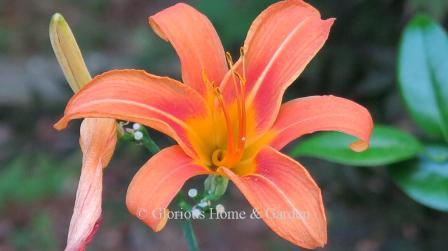 Hemerocallis fulva
Hemerocallis fulvaHemerocallis fulva ‘Kwanso,’ double daylily, Zones 3-9. The double form of H. fulva, has been used in the hybridization of fancy modern double cultivars.
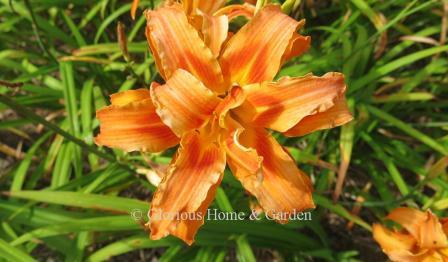 Hemerocallis fulva 'Kwanso'
Hemerocallis fulva 'Kwanso'Hemerocallis lilioasphodelus, lemon lily, Zones 3-10. The lemon daylily was beloved by early North American settlers for its dependability and fragrance. Today it is used in breeding new cultivars with an early blooming habit and excellent fragrance.
 Hemerocallis lilioasphodelus
Hemerocallis lilioasphodelusA Few Choice Daylily Cultivars
‘Aerial Applique’ is an eye-catcher in lavender with a darker violet halo and large golden yellow applique. Reblooms, tetraploid, semi-evergreen, to 32”.
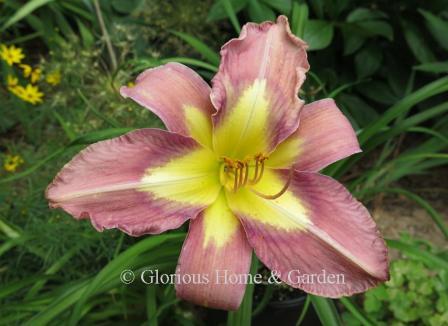 Hemerocallis 'Aerial Applique'
Hemerocallis 'Aerial Applique'‘Autumn Minaret’ is a very tall cultivar (to 66”), and the orange-yellow, narrow-petaled flowers with darker eye zone blooms from mid-summer into fall.
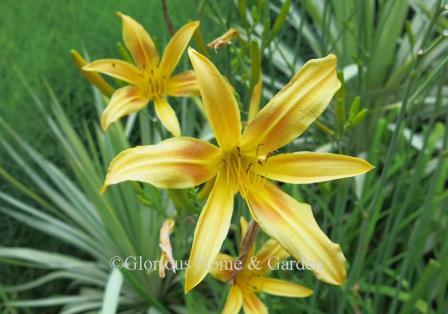 Hemerocallis 'Autumn Minaret'
Hemerocallis 'Autumn Minaret'‘Autumn Red’ is a bright red with rippled petal edges and a yellow heart with radiating yellow ribs down the center of each petal and sepal. Reblooms, diploid, dormant.
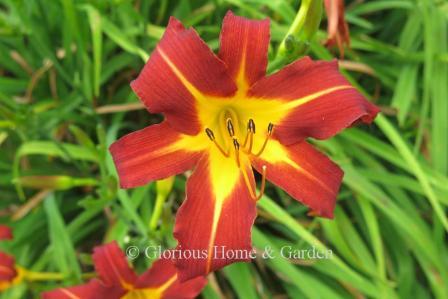 Hemerocallis 'Autumn Red'
Hemerocallis 'Autumn Red'‘Catherine Woodbery’ has soft lavender petals with paler sepals and a wide, glowing chartreuse heart. Introduced in 1967, this daylily continues its popularity due to its fragrance, long blooming season, and charm. Mid-to-late season, diploid, dormant.
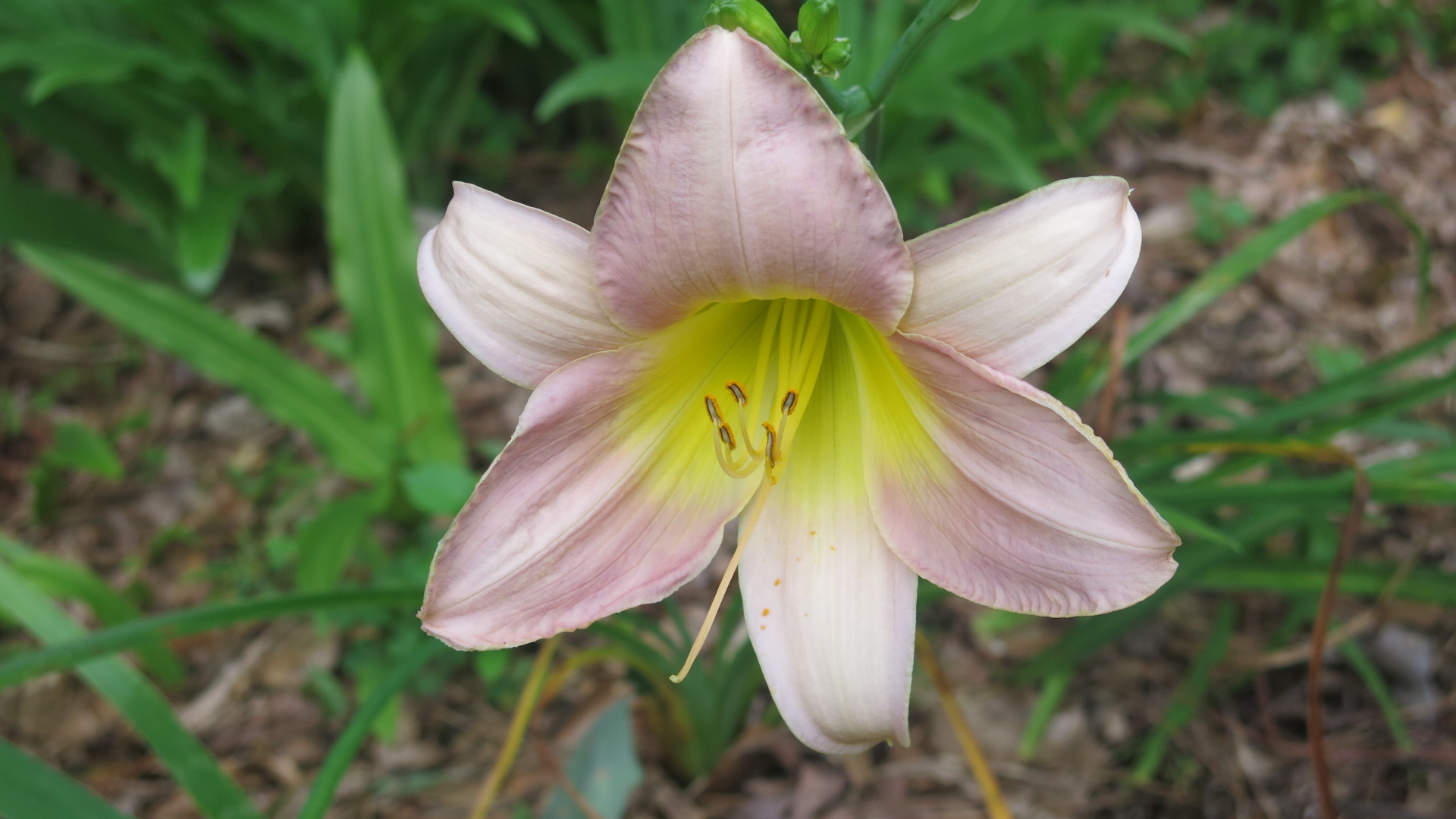 Hemerocallis 'Catherine Woodbery'
Hemerocallis 'Catherine Woodbery'‘Cherokee Star’ is a very bright red with broad gold applique throat. The color really makes an impact in the garden. Late midseason. Tetraploid.
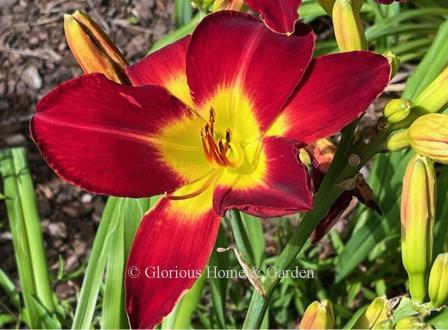 Hemerocallis 'Cherokee Star'
Hemerocallis 'Cherokee Star'‘Edith Sliger’ is a lovely rose pink with wide very ruffled petals edged in gold. Tetraploid, semi-evergreen.
‘Chokecherry Mountain’ has an unusual form. Not quite a spider, but the petals are narrow and somewhat folded while the tepals are quite narrow and also folded, giving the flower an open, loose appearance. The throat is green. Midseason, diploid, semi-evergreen.
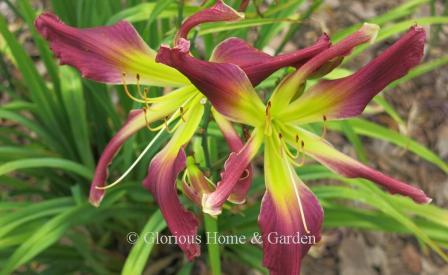 Hemerocallis 'Chokecherry Mountain'
Hemerocallis 'Chokecherry Mountain'‘Cosmic Struggle’ is a rich cranberry red color with a lavender watermark, tightly crimped ivory edge, and yellow throat. Midseason bloomer, tetraploid, reblooms, fragrant, semi-evergreen.
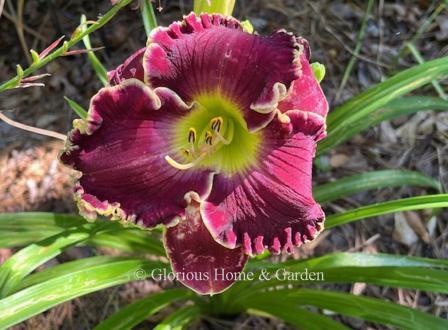 Hemerocallis 'Cosmic Struggle'
Hemerocallis 'Cosmic Struggle'‘Country Music Queen’ is a double in rose with a yellow throat. Midseason to late, diploid, semi-evergreen, reblooms.
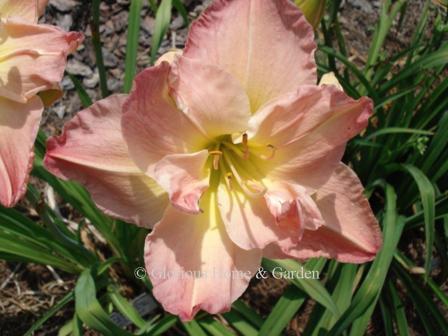 Hemerocallis 'Country Music Queen'
Hemerocallis 'Country Music Queen'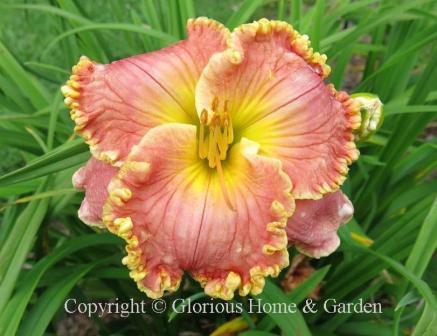 Hemerocallis 'Edith Sliger'
Hemerocallis 'Edith Sliger'‘Endless Heart’ is a rosy-red self with wide petals and tepals giving it a rounded shape set off by a yellow-green heart. Early bloomer, diploid, evergreen, reblooms.
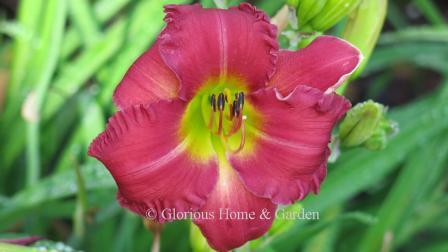 Hemerocallis 'Endless Heart'
Hemerocallis 'Endless Heart'‘Fairy Tale Pink’ was the Stout Silver Medal Winner 1990, the highest daylily award. Pink self with green throat, ruffled petals and sepals. Diploid, semi-evergreen.
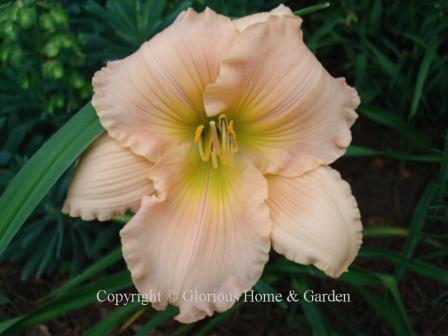 Hemerocallis 'Fairy Tale Pink'
Hemerocallis 'Fairy Tale Pink'‘Fragrant Returns’ is a soft lemon yellow self with slightly ruffled edges. It is akin to ‘Happy Returns’ but a little paler. Fragrant, reblooms.
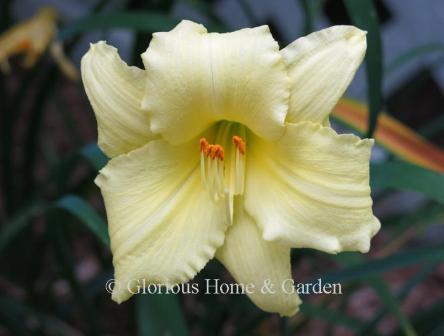 Hemerocallis 'Fragrant Returns'
Hemerocallis 'Fragrant Returns'‘Francis of Assisi.’ One from the Trophytaker® series of daylilies, ‘Francis of Assisi’ is a lovely bright wine red with a white picotee edge and green throat. This semi-evergreen tetraploid is very vigorous.
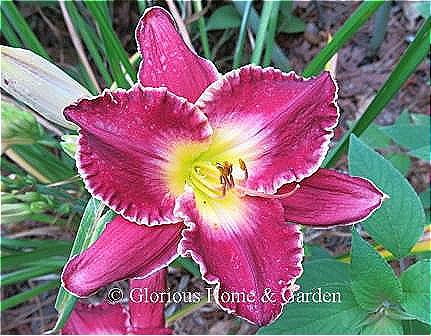 Hemerocalliis 'Francis of Assisi'
Hemerocalliis 'Francis of Assisi'‘Hyperion’ is a classic dating from 1924. Blooms stay open an unusually long time, up to 19 hrs. A light yellow self, dormant, diploid, fragrant, rebloomer, to 40”.
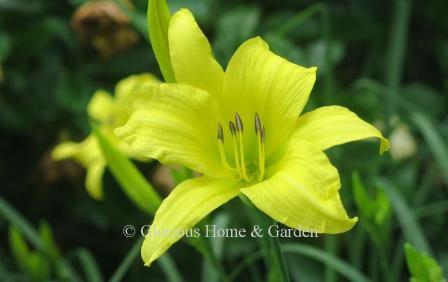 Hemerocallis 'Hyperion'
Hemerocallis 'Hyperion'‘Joan Senior’ is a near-white self with green throat often used by hybridizers in the search for the elusive pure white daylily. Diploid, evergreen.
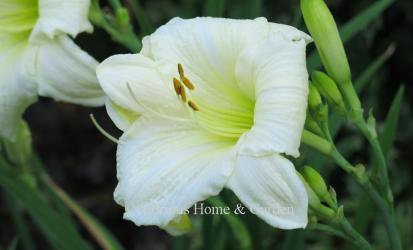 Hemerocallis 'Joan Senior'
Hemerocallis 'Joan Senior'‘Luxury Lace’ is a classic daylily from 1959 with rippled lavender-pink petals a little darker than the sepals. Stout Silver Medal winner of 1965. Diploid, dormant, reblooms.
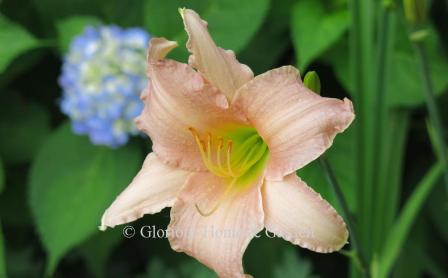 Hemerocallis 'Luxury Lace'
Hemerocallis 'Luxury Lace'‘Nosferatu’ is another of the Trophytaker® series of daylilies. Very strong and vigorous, this semi-evergreen tetraploid is a deep purple self with chartreuse throat and very heavy substance.
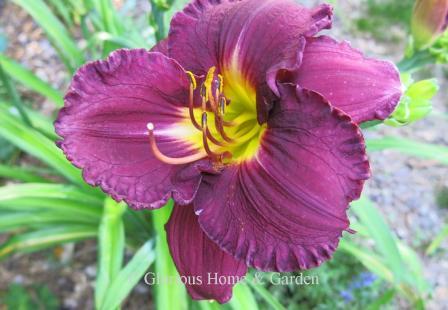 Hemerocallis 'Nosferatu'
Hemerocallis 'Nosferatu'‘Palace Garden Beauty’ is a ruffled lavender with white midribs and darker lavender watermark and yellow throat. Evergreen, tetraploid.
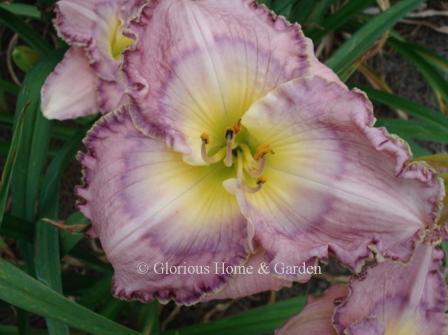 Hemerocallis 'Palace Garden Beauty'
Hemerocallis 'Palace Garden Beauty'‘Pandora’s Box’ is a creamy near white with a purple eyezone and yellow throat. Petite in size, it grows to about 20.” Reblooms, diploid, evergreen.
 Hemerocallis 'Pandora's Box'
Hemerocallis 'Pandora's Box'‘Persian Pattern’ has a simpler form that harkens back to the species, but this yellow and purple bitone adds a striking chevron pattern on the petals and fainter echo on the sepals. Diploid, dormant.
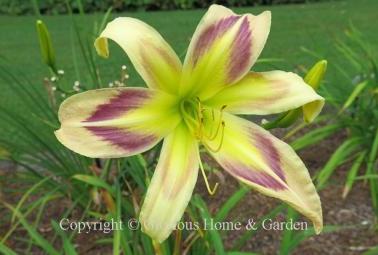 Hemerocallis x 'Persian Pattern'
Hemerocallis x 'Persian Pattern'‘Prairie Blue Eyes’ is a gorgeous color, a lavender with a subtle deeper purple eyezone and bright yellow throat. The petals have a strongly defined central rib, and the sepals recurve. Diploid, semi-evergreen.
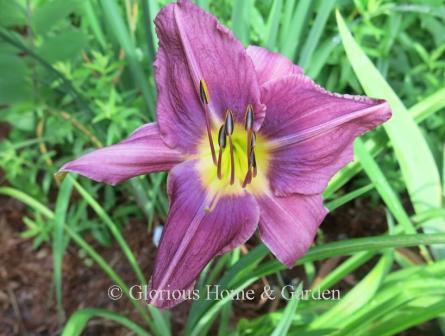 Hemerocallis 'Prairie Blue Eyes'
Hemerocallis 'Prairie Blue Eyes'‘Primetime Sunshine,’ from BlewLabel® Perennials, is a charming yellow self with ruffled and puckered petals and contrasting dark scapes, and it reblooms. Semi-evergreen, diploid.
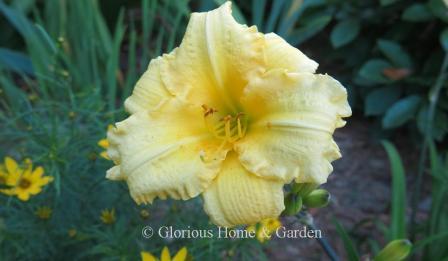 Hemerocallis 'Primetime Sunshine'
Hemerocallis 'Primetime Sunshine'‘Red Rooster’ struts its bright red color with panache. This late season bloomer is tetraploid and goes dormant in winter.
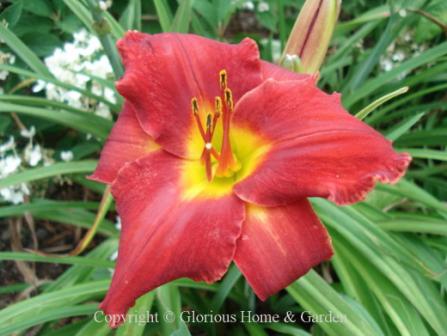 Hemerocallis 'Red Rooster'
Hemerocallis 'Red Rooster'‘Royal Braid’ sports a deep purple eyezone with matching braid on the ruffled petal edges on a lighter lavender ground. Tetraploid, semi-evergreen, reblooms.
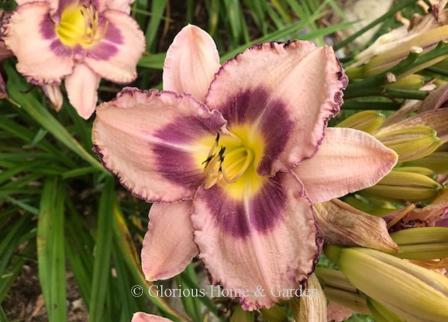 Hemerocallis 'Royal Braid'
Hemerocallis 'Royal Braid'‘Royal Frosting’ is from the Trophytaker® series of daylilies. A pale cream near-white self, with green throat, ruffled and diamond-dusted. It is early to open and late to close in the evening. ‘Joan Senior’ is in its parentage. Diploid, dormant.
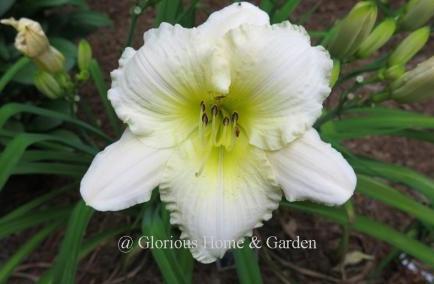 Hemerocallis 'Royal Frosting'
Hemerocallis 'Royal Frosting'‘Ruffled Apricot’ was the Stout Silver Medal Winner for 1982. Beautiful apricot self that glows in the garden. Tetraploid, dormant.
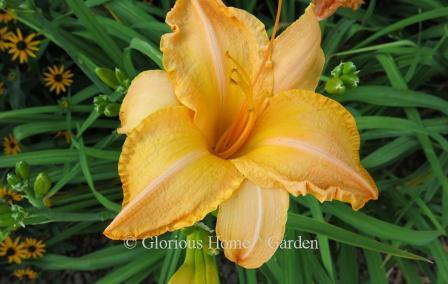 Hemerocallis 'Ruffled Apricot'
Hemerocallis 'Ruffled Apricot'‘Ruffled Pastel Cheers’ just glows in the garden in pastel yellow with a hint of peach and very ruffled petals. Tetraploid, dormant.
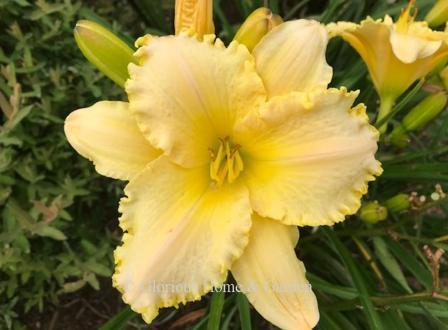 Hemerocallis 'Ruffled Pastel Cheers'
Hemerocallis 'Ruffled Pastel Cheers'‘Stephanie Returns’ is a rose bitone with a deeper rose eyezone with deep rose veining extending into the petals. The petals are a bit lighter than the tepals. Early, diploid, dormant, reblooms.
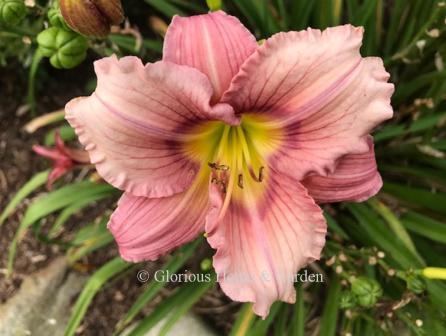 Hemerocallis 'Stephanie Returns'
Hemerocallis 'Stephanie Returns'‘Strawberry Candy’ was the Stout Silver Medal Winner for 1998. Unusual strawberry-pink with striking darker eyezone. Tetraploid, semi-evergreen.
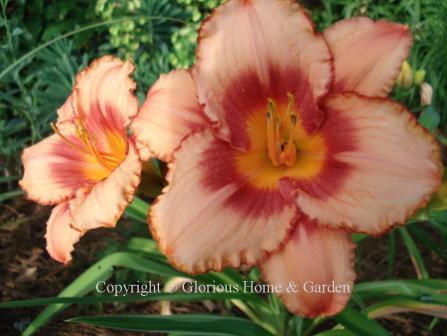 Hemerocallis 'Strawberry Candy'
Hemerocallis 'Strawberry Candy'‘Temple Goddess’ is a soft peach ruffled self with golden throat. Tetraploid, evergreen.
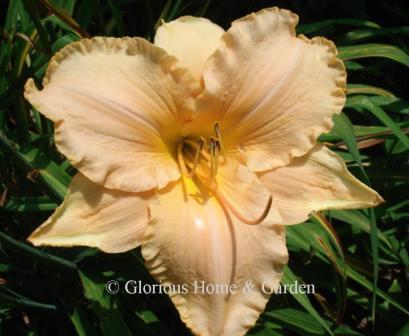 Hemerocallis 'Temple Goddess'
Hemerocallis 'Temple Goddess'‘Winning Ways’ was the Stout Silver Medal Winner 1974. This is probably the oldest plant in my garden having come with me on several moves over the years. It is a large soft yellow self with somewhat recurved petals and sepals, opens early and stays open late. Diploid, dormant.
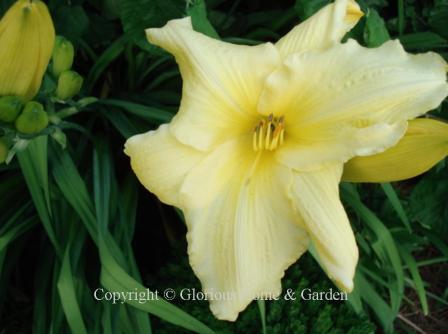 Hemerocallis 'Winning Ways'
Hemerocallis 'Winning Ways'